Among the many noteworthy species and cultivars in the Origanum genus, I credit a ‘Hot and Spicy’ oregano plant with kick-starting my home cooking regimen 10 years ago.
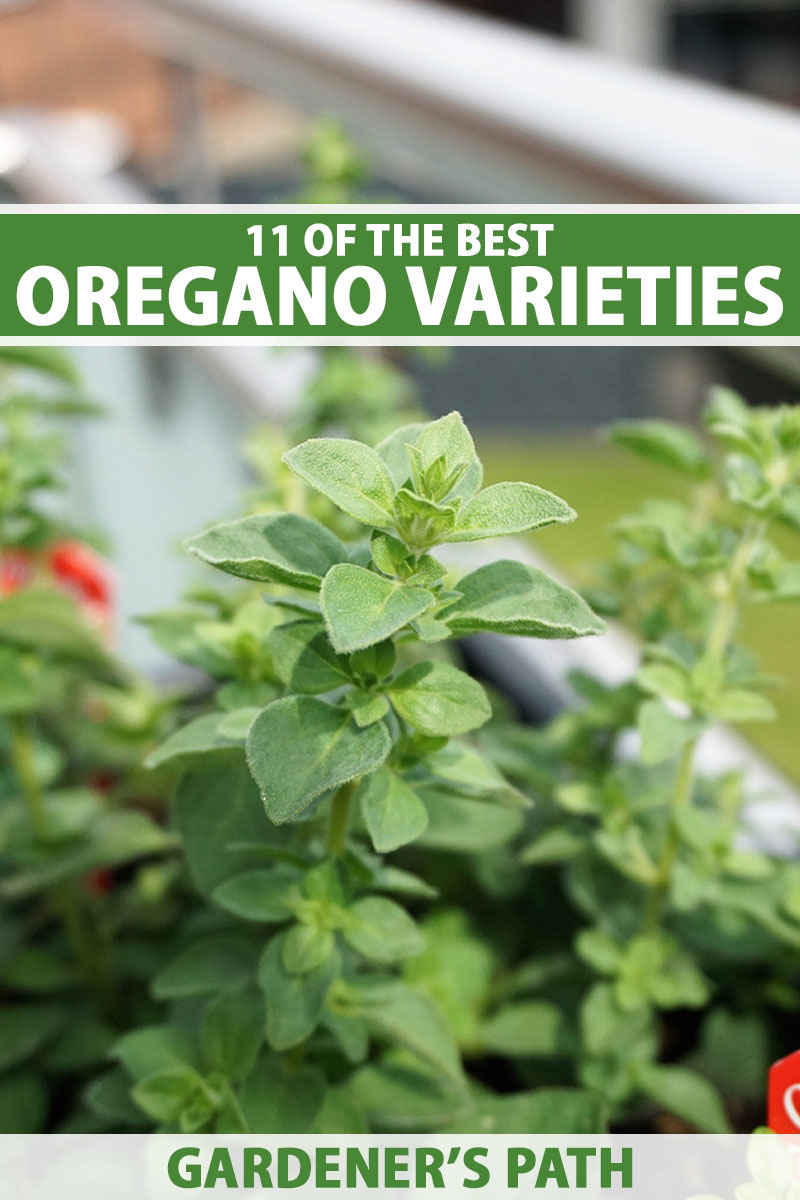
We link to vendors to help you find relevant products. If you buy from one of our links, we may earn a commission.
When I bought this variety from a vendor at our local farmers market, I’d been sinking into one of those lackluster periods where I seemed to subsist mostly on take-out.
At random, I added several stems-worth of its tender leaves to a slow cooker stew recipe, and the result was fragrant and satisfying without being overpowering.
Wow! From there, I seemed to have a new reason to cook at home at least once a day.
All these recipes featured leaves and stems from my fast-growing plant, from quiche and minestrone to dips and spaghetti sauces.
Before I realized it, oregano had lifted that months-long mood, and I was back in the kitchen and eating well.
Are you in the mood for a similar lift from an herbaceous perennial? Along with ‘Hot and Spicy,’ other plants in this genus of about 20 species have much to offer.
Their attributes include flavorful leaves, drought and cold tolerance, an ability to attract pollinators, and a heady fragrance from abundant tiny blooms.
Many types, like Greek oregano or wild za’atar, can perk up your weekday cooking and may even encourage you to experiment with new cuisines.
If you only associate oregano with a shaker of aged little green bits, growing one of these varieties for cooking will be a palate-pleaser, for sure.
There are also varieties without a good flavor that aren’t meant for eating – ornamentals like the hybrid ‘Kirigami’ that are standouts for hanging baskets, ground cover, and attracting pollinators.
In this guide, we’ll present 11 of the best types of oregano for the home gardener.
We’ve (ahem) weeded through many cultivars and species within the Origanum genus to make it easier to select an option that will delight you.
Here’s the lineup:
11 of the Best Types of Oregano
For home gardeners, it’s important to distinguish ornamental oregano from culinary types.
Though I would say all types of oregano are attractive, and they will bloom with pink, purple, or white flowers, some are extra-lovely grown in baskets, borders, or pollinator gardens.
Those types tend to have little flavor, though, and the oreganos that are taste sensations are more modest in appearance.
If you’re looking for Cuban (Coleus amboinicus) or Mexican (Lippia graveolens) oregano, note that while these species have a similar taste profile, they’re not considered true oreganos, and each is in a different genus than the plants we’ll discuss here.
But please do jump over to our Cuban or Mexican oregano guides for more info.
Will you go for looks or cooking? Your choice! Here are 11 types to consider:
1. Common
The name of this type might leave you wondering when the word “vulgar” became synonymous with being coarse, obscene, or gross.
But regardless of today’s more blatantly negative connotation in English, O. vulgare does in fact roughly translate to common oregano.
Its green stems and bushy, velvety green leaves are lively and robustly scented. This species is really quite wonderful.
If taxonomists would let me rename this charming plant, and if English words were allowed, I’d call it O. versatile.
Not only can it survive deer foraging, drought, poor soil, and cold winter temperatures, you can grow it in all types of herb gardens, as a ground cover, or in a hanging basket.
Native to Europe and Asia, common oregano can grow one to three feet tall and spread a foot or two via underground runners.
Its leaves are fragrant, as are its purple-pink or white blooms, which attract pollinators.
It’s a perennial, hardy in Zones 4 to 8. but many gardeners and cooks just grow it as an annual with other mint relatives like basil or thyme.
Find common oregano seeds in packets and bulk from Eden Brothers.
2. Dittany of Crete
O. dictamnus, usually called dittany of Crete, has been around since the days when an herbaceous poultice was one of the only viable medical treatments for wounds and abrasions.
In the “Aeneid,” the epic poem completed by Virgil in 19 BCE, the goddess Venus harvests dittany from Mount Ida on Crete and uses it to cure the protagonist Aeneas’ arrow wound.

Wouldn’t it be fun to grow a fragrant ground cover with such a far-reaching history?
Native to mountainous regions where fleet-footed goats gambol, this sub-shrub still grows wild where it originated, in the Dicte mountain range that comprises vast areas of Crete.
But now it’s prized in many gardens more for its looks than its medicinal value.
Though you can use the leaves dry or fresh to flavor soups and such, other types have superior intensity and flavor. But its link to mythology is not the only reason to grow dittany of Crete in modern times. It also makes an attractive ground cover in inhospitable spots.
Attaining about a foot in height and spreading 18 to 24 inches, dittany of Crete has a mounding growth habit that covers bare spots and it can thrive in rock gardens or sandy soils.
Its fragrant, minty leaves can be up to an inch wide and they’re a striking shade of green, occasionally splashed with purple. They grow thick on the stems and sport white, fuzzy hairs.
The pinkish-purple flowers have layered clusters of petals that look sort of like miniature hoop skirts or maybe hops flowers.
The latter comparison inspired the alternative name hop marjoram. Each bloom is cradled by a bract that matures from green to a bright purple as seeds form.
It’s important to heed some precautions before choosing to grow this type of oregano in containers, the garden, or your landscape:
Keep in mind, it does not withstand cold nearly as well as some other types. While some oreganos can survive the cold in Zone 5 or even 4, dittany of Crete is hardy only in the milder climates of Zones 7 to 10.
While it can grow in part shade and tolerates heat and drought, like other varieties of oregano, it can’t hack high humidity and well-draining soil is a must.
3. Drops of Jupiter
I wasn’t sure how to make sense of this cultivar’s name when I first came across it.
But according to Nicole Hoonhorst, PR Specialist at Walters Gardens, ‘Drops of Jupiter’ was named for its fantastical coloration, with “drops” alluding to the numerous flowers it produces.
Hybrid ‘Drops of Jupiter’ may sweep you off your feet with its ornamental value: showy chartreuse leaves and stems offset with profuse clusters of pink flowers surrounded by rich purple sepals.
Grow this variety in full sun and it will reward you with even more vibrant color.
While you technically could eat the leaves, their flavor is inconsequential – far milder than leaves from varieties bred for cooking.
‘Drops of Jupiter’ blooms later and longer than other oreganos, from midsummer to early autumn.
Plants reach 18 to 24 inches tall, and it spreads quite handily to fill up large containers or bare spots in borders and rock gardens. It can grow three feet wide as it matures.
The plants are hardy in Zones 4 to 9, so you can rely on them to come back season after season even in cooler climates.
Live plants are available from Burpee.
4. Golden
All that’s gold does not glitter…
Take golden oregano, O.vulgare ‘Aureum.’ While it’s in no way shiny, it does sport lovely greenish-gold leaves. And it is quite valuable, though not in buried treasure terms.
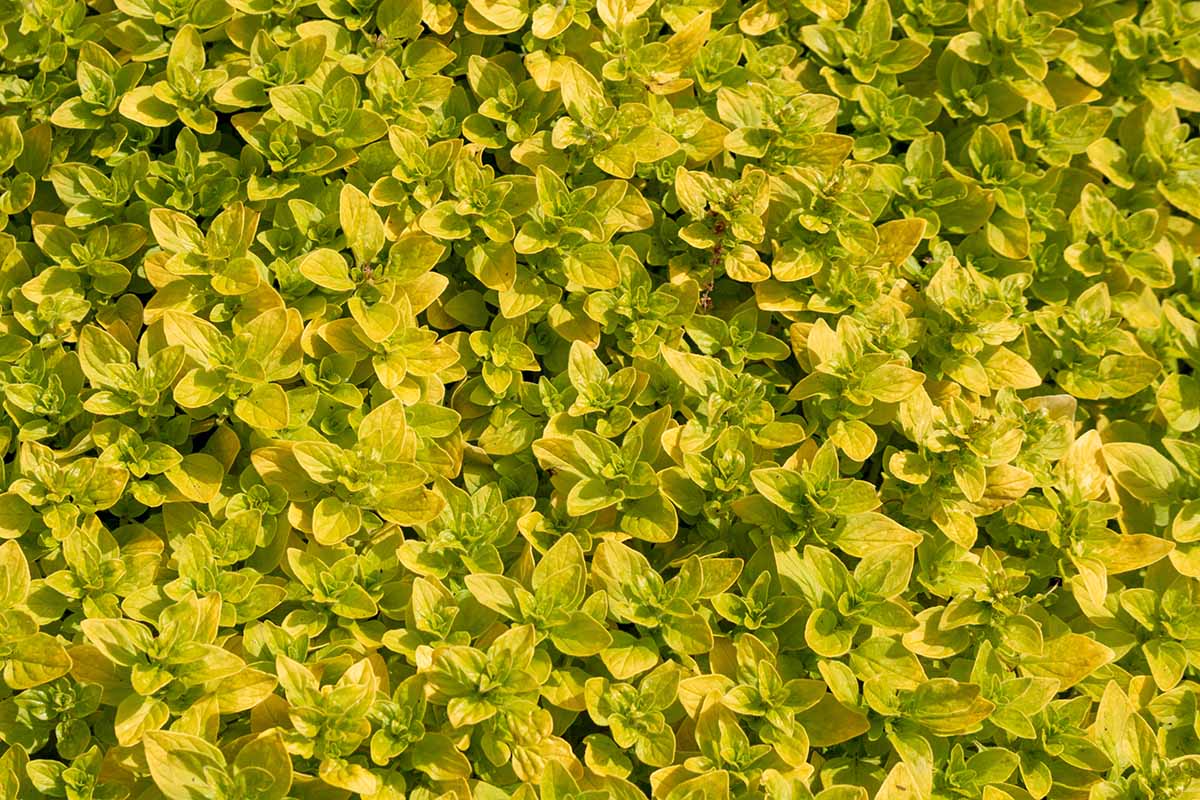
No, this plant proves its worth as a ground cover, culinary herb, pollinator magnet, and deer-resistant garden plant.
The bright leaves complement other shrubs in the landscape or flower border, too, and brighten up gloomy spots with their color.
It’s even relatively cold tolerant and can be grown as a perennial in Zones 4 to 8.
‘Aureum’ will grow six to 12 inches tall handily and it spreads readily to a width of 18 inches. If you’re growing it for culinary purposes, it’s best to pinch the buds before they flower to keep the foliage from becoming bitter.
Along with other oregano varieties with light-colored or variegated leaves, the golden variety needs protection from harsh afternoon sunlight.
That’s easy enough to provide, either by situating the plants in a part-shade location or with the strategic use of shade cloth. That seems like a small price to pay for this golden opportunity…
Plants are available in mix-and-match three-packs from Burpee.
5. Greek
Here’s one situation where the phrase “It’s all Greek to me!” has a positive spin.
Greek oregano, O. vulgare ssp. hirtum, is a bit more pungent than its Italian counterpart – another variety commonly used in cooking that we’ll cover a bit later in this roundup.
But this culinary oregano is a standout for seasoning all types of Mediterranean cuisine.
Happily, this fast-growing, mounding plant grows about two feet tall and wide, rapidly multiplying via underground runners. It will produce plenty of soft, hairy leaves to cook with and dry for later use.
You can grow it as part of a kitchen garden or in a window box, but don’t overlook the option to grow Greek oregano as an herbal ground cover, even in chillier areas.
It’s hardy in Zones 5 to 10 and will tolerate both poor soil and drought, just as long as you grow it in full sun and well-draining soil.
Greek oregano seeds are available in packets and in bulk from Eden Brothers.
6. Hot and Spicy
Here’s that culinary oregano that reignited my passion for home cooking!
This O. vulgare cultivar isn’t ghost pepper or even jalapeno-level on the Scoville scale, but it does have a bit of a bite.
It’s handy for those who like to cook Tex-Mex dishes or who season with copious black pepper and want to add a similar heat with a more vegetal, fresh herb option.
Low-growing and bushy, ‘Hot and Spicy’ reaches 24 to 30 inches tall with an equal spread.
It is cold hardy in Zones 5 to 9, which means you can harvest the leaves to cook with long after homegrown chilies have died off or been plucked clean for winterizing.
The white flowers that bloom in summer are also edible, but be sure to pinch off the buds if you’re still harvesting leaves. Once the plant flowers, the flavor of the leaves becomes overly pungent.
Try fresh, minced leaves in jarred salsa or as a garnish atop homemade enchiladas.
Or, warm the leaves in a bit of olive oil to bring out their flavor, and use the oil as a finishing swirl in vegetable soups or to dip bread.
‘Hot and Spicy’ oregano is available as part of a three-plant mix-and-match set from Burpee.
7. Italian
Origanum x majoricum is the botanical name, but this type is often called Italian oregano – or maybe we should say “Italian American.”
Native to the Mediterranean, this oregano hybrid is also known as hardy marjoram. It has a more subtle, sweeter flavor than Greek oregano and is featured at pizzerias and in frozen foods across the US and elsewhere.
This is a great plant for herb garden beginners looking for a flavor powerhouse to try their hand at. The leaves can be used in dishes from fish and salads to stews and, yes, Italian tomato sauce.
Like all culinary oregano, this herb is far milder fresh than dried, so be prepared to use about three times more than you would from the garden if you were dipping into a jar from the pantry.
Both the stems and fuzzy little mint-green leaves are edible, and they can be frozen in butter, dehydrated, or air-dried. You’ll have plenty to harvest if you choose to grow this variety since it will attain 12 to 24 inches tall and spread 12 to 18 inches wide.
The flowers are white or pink and fragrant. They’ll draw pollinators and assail your senses if you plant this herb near an outdoor kitchen or patio. You might find the blooms tasty, too. They’re attractive as garnishes or to flavor herb butter or soups and stews.
For more information about harvesting and cooking with edible flowers, see our guide.

Note that these plants aren’t quite as cold-tolerant as some others, hardy in USDA Zones 6 to 9, so be sure to grow it in containers so you can bring it indoors if you want to keep the season going when temperatures plummet.
Italian oregano is available in four-packs of live plants from Bonnie Plants via Amazon or in 1000-seed packets from IB Prosperity via Amazon.
8. Kent Beauty
‘Kent Beauty’ may sound like the winner of a pageant in a southeast England hamlet, but it’s an ornamental plant – and one that’s quite likely to win first prize in a flower contest.
In fact, this hybrid cultivar earned a Royal Horticultural Society Award of Garden Merit in 2012.
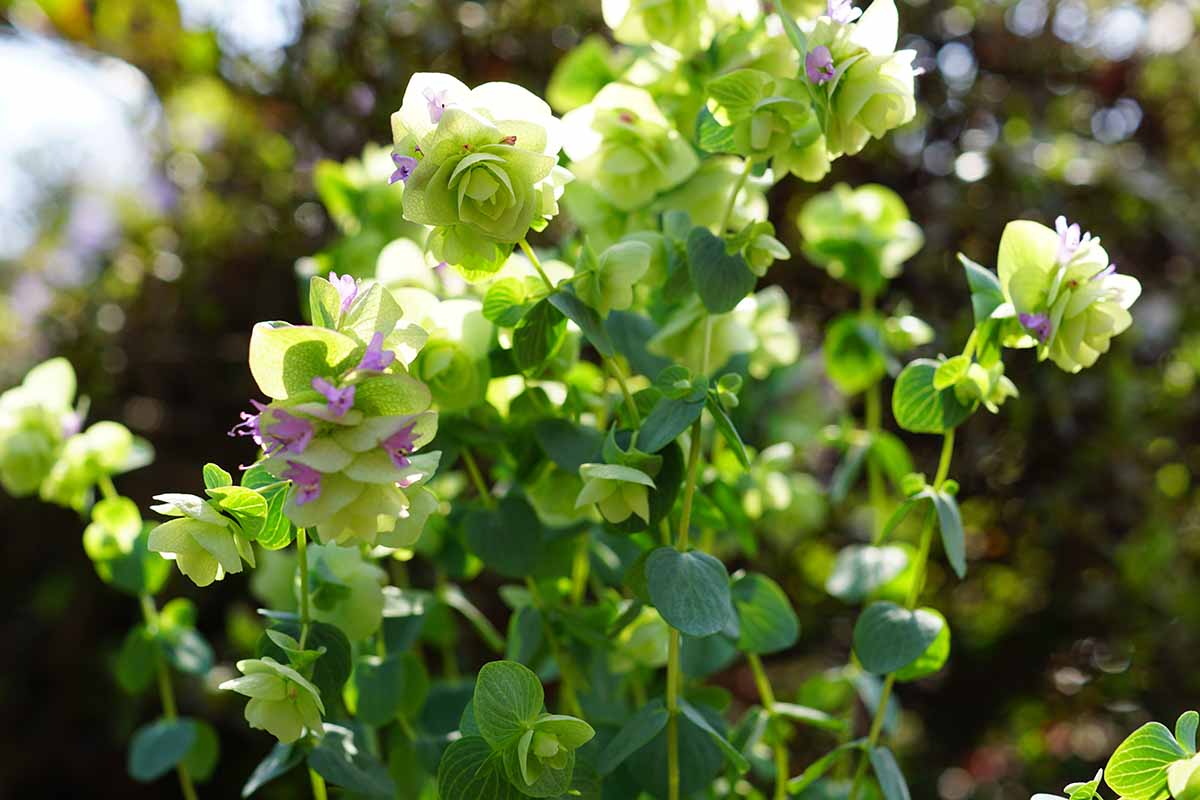
You can grow it as a perennial in USDA Hardiness Zones 6 to 9 and everywhere else as an annual or a plant that overwinters indoors.
The shrubby beauty reaches about 10 inches tall and fills out to about 12 inches in diameter. The stems will drape luxuriously from window boxes or hanging baskets, each densely packed with oval-shaped, silver-veined leaves.
In summer, the elegant foliage is joined by blooms that consist of whorled pink, light green, or white bracts that droop like hops flowers. The overall effect is sweet pre-flowering and glamorous after the pendulous blossoms begin to bloom.
Don’t be misled into thinking this plant is delicate based on its showy foliage and flowers, though. ‘Kent Beauty’ will thrive in sandy soil and it tolerates heat and drought like other oreganos.
Just remember to deadhead to keep this hybrid full and flowering. And plant it only in well-draining soil and porous containers like unglazed terra cotta.
It will waft an unmistakable oregano scent, but don’t plan to cook with the leaves or blooms. They’re edible, but not very palatable – they aren’t pungent enough to impart flavor to your favorite dishes.
9. Kirigami
Hardy in Zones 5 to 8, ‘Kirigami’ is a good choice for those who need an ornamental option tolerant of cool weather that’s known to attract pollinators.
The plant is elegant, sporting light green leaves with dusty rose accents. It blooms in a profusion of fragrant, tiny, pinkish-purple flowers in late spring and summer. Bees and butterflies cannot leave them alone.
Another part of its appeal is its mounding habit, which works well to cover bare spots in the landscape, or it can be used to grow between pavers in walkways.
This cultivar will also drape attractively from a hanging basket that can move indoors for the cold months if you’d like.
Drought tolerant, ‘Kirigami’ is also a candidate for rock gardens and xeriscaping.
It has a more modest height than some of the culinary oreganos, growing just eight to 10 inches tall and spreading 12 to 14 inches wide.

A variation of the Japanese paper-folding art form known as origami, in kirigami the paper is cut as well.
As an art that I often associate with winged creatures and graceful fluttering, it’s easy to remember the key characteristics of ornamentation and attracting butterflies and bees with a cultivar of this name.
Find ornamental ‘Kirigami’ oregano in 20-seed packets from Park Seed via Amazon.
10. Marjoram
Italian oregano is sweeter than Greek, and sweet marjoram, O. majorana, is sweeter still. It yields a delicate piney flavor with a bit of citrusy zip for added dimension.
I can’t help but associate it with chicken fricassee, a favorite of cooks in my suburban neighborhood back in the 1980s.
That 18th-century dish is still prepared with marjoram in home kitchens and restaurants alike, such as the Mount Vernon Inn restaurant, where diners are invited to enjoy “the flavors of early America” at George Washington’s estate.
This is a compact herbaceous perennial that’s sure to pep up your meals. It reaches just 12 to 24 inches tall and is ideal for containers and small-space herb gardens. In the winter, pot up a division to bring indoors!
Drought tolerant, marjoram is also a candidate for xeriscaping.
Marjoram doesn’t grow as quickly as its oregano relatives, nor is it as tolerant of cold, hardy only in Zones 7 to 10.
Find marjoram seeds in various packet sizes at Eden Brothers.
11. Wild Za’atar
Wild za’atar is a variety that I associate with another word that starts with Z – zesty. And that makes it easy to remember!
This pungent, tender perennial encompasses both oregano and peppermint in its intense flavor. Zing!
O. syriacum is also known as Syrian oregano. And some believe it to be the species referred to as hyssop in the Bible.
This herb packs a powerful punch and looms large in the garden. It can grow four feet tall and wide, and its aroma matches the intensity of its flavor.
The huge plants draw bees and butterflies in late summer when their spiky clusters bloom with two-lipped, tiny pink or white flowers.
You may have already eaten some dried Syrian oregano as part of the popular Middle Eastern spice mix also commonly known as za’atar, but its flavor is especially appealing when you use the fresh sprigs or leaves as a garnish, or for seasoning pilafs and kabobs.

If you’d like to grow this piquant, aromatic herb, you may want to consider planting it as an annual, or taking cuttings or divisions to overwinter indoors.
O. syriacum is only hardy in Zones 9 to 10, and it cannot withstand chilly temperatures outdoors.
Find wild za’atar available in 30-seed packets from Palm Beach Medicinal Herb Store via Amazon.
Say Yes to Oregano
The many types of oregano plants are all relatively easy to grow and share.
Species plants and some cultivars can be propagated from seed, even indoors, and you can also propagate plants from cuttings or divisions.
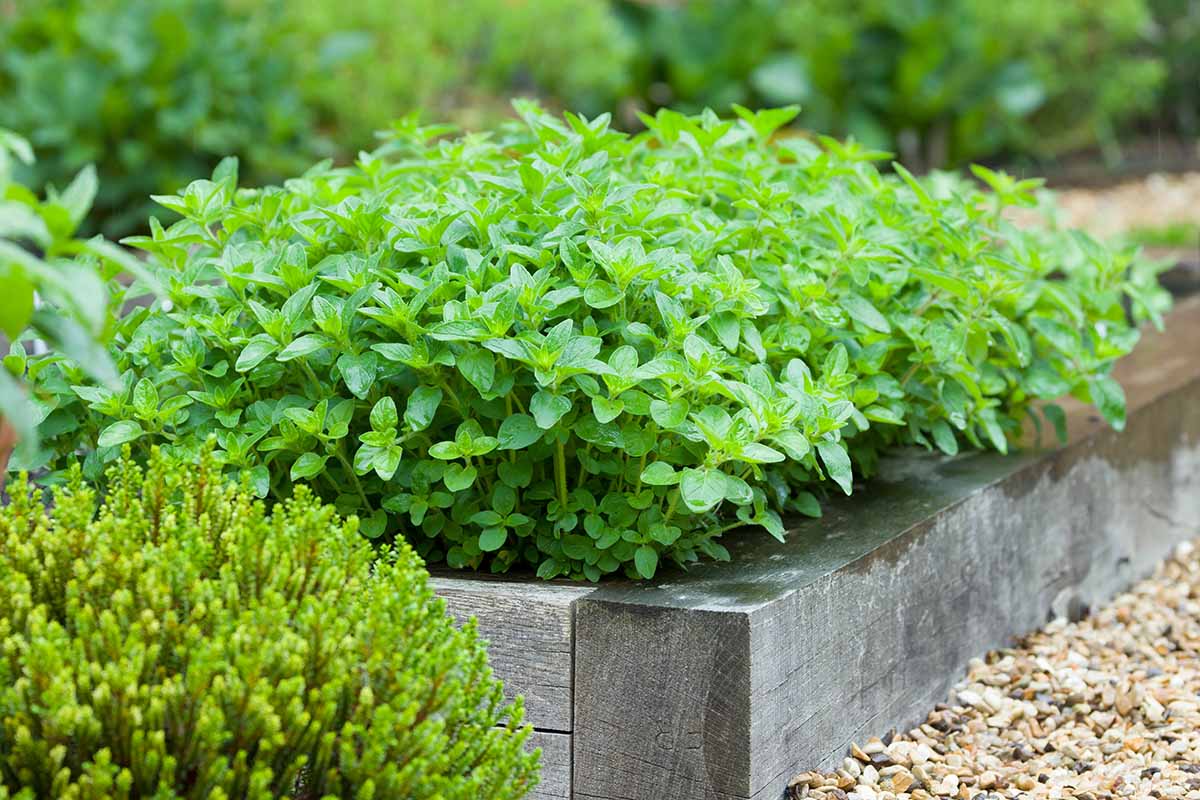
I mention this in case you agree that while planting one type of oregano is lovely, growing several varieties gives you even more opportunities to appeal to pollinators, inhale marvelous scents, and add distinct flavors to different cuisines.
Do you have a favorite among the 11 types I covered, or perhaps another cultivar or species you’ve enjoyed growing in your herb garden or landscape? Kindly weigh in with comments below, or post any questions you have.
Then take a closer look at oregano and some other perennial herbs in the mint family with these guides:
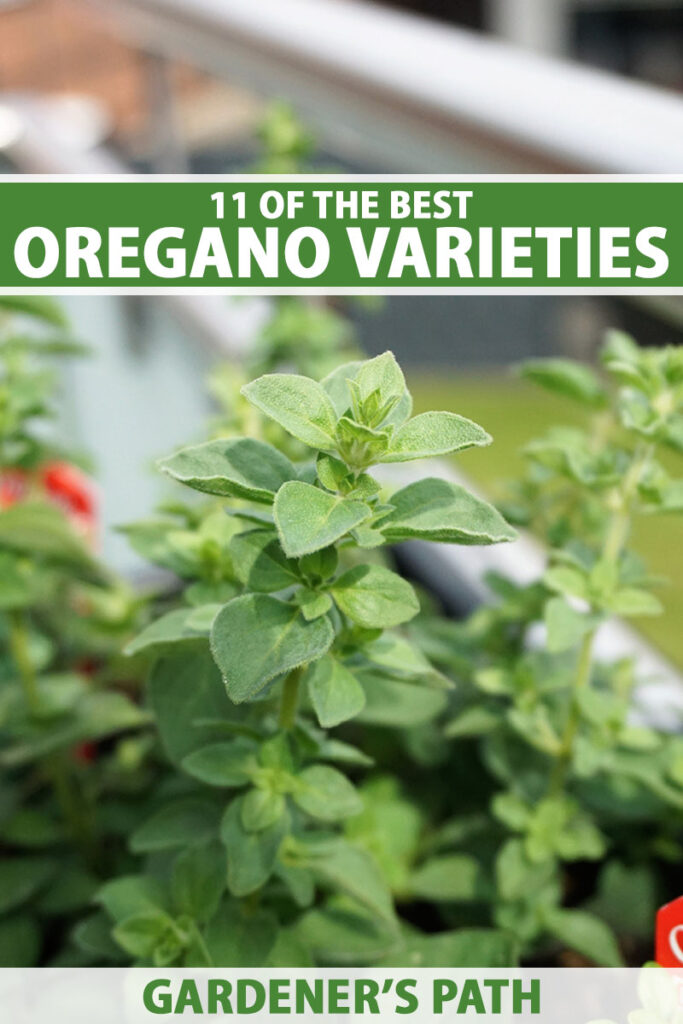
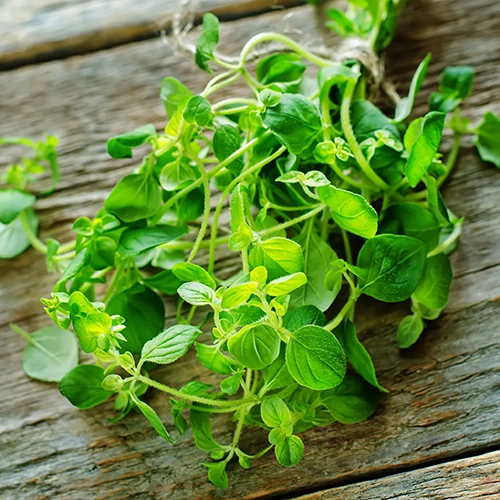

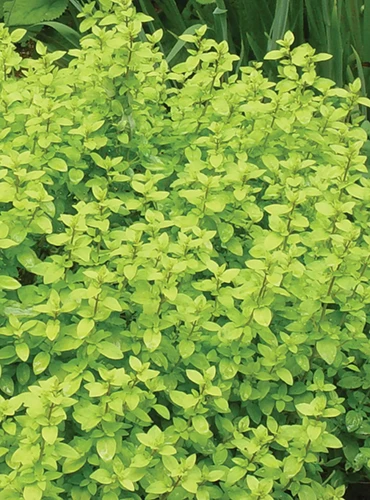

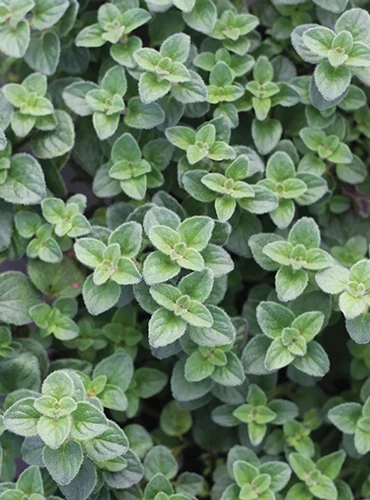
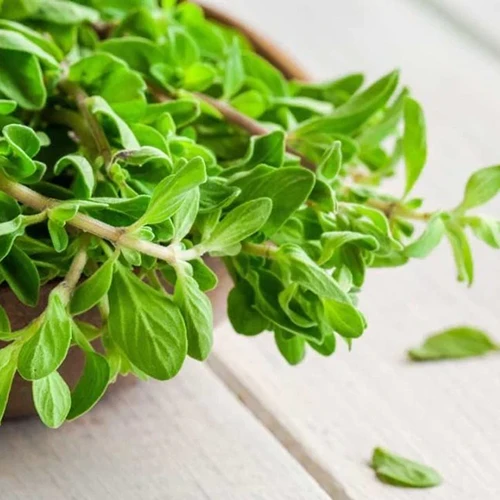
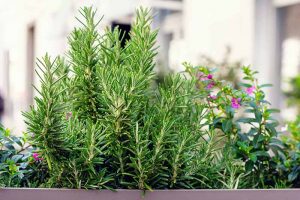

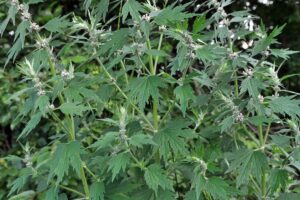
Is there a particular variety that you’re looking for? If you follow the links provided you can check current prices and purchase seeds from our trusted affiliates.
Hi, I have been looking for an oregano variety that did not regrow after a move. I miss it terribly. I have tried a number of varieties but they don’t taste the same, or smell as strong. The variety I am looking for had purple stems, elongated dark green leaves and white flowers. The leaves were NOT as wide closer to the stem, and were smaller than some other varieties. It grew like a bush. Each stem was about 2 ft tall. It did not spread too much horizontally. It appeared similar to the attached pictures, though I am not… Read more »
Hi Sue, that’s a shame that your beloved oregano couldn’t survive the move!
Could you get a look at our Cubano oregano guide and tell me if this is by chance the one you’re thinking of? You did say the leaves weren’t wider near the stems, so this may not be it.
Check it out and get back to me–we’re happy to corral some more ideas in aid of your search.
Good luck!